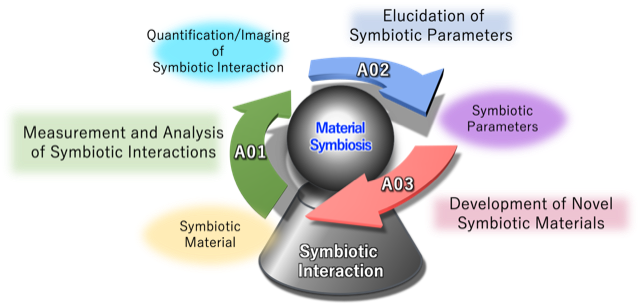Purpose of the Research Project
In our body, we have some amazing symbiotic relationships with other organisms. The relationship between a mother and her unborn baby is a representative example of them. The mother does not reject her fetus, even though the fetus is completely another organism. This symbiosis is achieved via “symbiotic communications” between mother and fetus using an intricate and fascinating system, the placenta. Another intriguing example is the relationship between humans and our intestinal bacteria, which is also based on a “symbiotic communication” to form the intestinal microbiota unique to individuals.
Although many different types of functional molecules, including biological drugs and biocompatible materials, have so far been developed, symbiosis between humans and non-self molecules/materials has not fully been established; even highly optimized advanced drugs exhibit immunogenicity in some cases, and this immunogenicity has become a major challenge for clinical applications.
We have just started an unique research project to define what exactly is “material symbiosis.” The primary goal of our material symbiosis project is to delineate previously-neglected, weak but specific interactions between living cells/biomolecules and materials, and eventually find ways to achieve material symbiosis in our body. In the end, we are hopefully able to compile knowledge obtained through this project, and establish a new field–what we call “biophysical chemistry for material symbiosis.”

Content of the Research Project
Three research groups pursue individual goals to elucidate underlying interactions between living cells/biomolecules and materials from biophysical chemistry perspectives and to overcome the issues addressed above. We keep close contact to share findings obtained in each group as well as actively collaborate within this material symbiosis project to achieve our overall goals.
[A01] The A01 research unit is a center for measurement of “weak interactions” for material symbiosis. It is not easy to visualize and quantify the fast and unstable interactions that occur in living organisms; therefore, we try to develop novel imaging systems, structural analyses, physicochemical analyses, computational approaches, and other methods to identify symbiotic weak interaction.
[A02] In the A02 research unit, we are specifically focusing on interactions between biomolecules and materials. These interactions can be broken down into various elementary interactions, such as electrostatic, hydrogen bonding, hydrophobic, van der Waals forces. We translate the relationship between biomolecules and materials into more fundamental biophysics and chemistry terms such as thermodynamic, kinetic parameters, and other possible variables.
[A03] The goal of the A03 research unit is designing and creating novel materials that symbiotically interact with biomolecules. Such materials will be developed based on the unique knowledge of symbiotic interactions obtained in this program. We also analyze the biological responses induced by these functional molecules.

Significance and Expected Achievements of the Project
Our mission in this research project is to elucidate relationships between biomolecules and materials in terms of biophysical chemistry and to develop biomaterials that exhibit desired relationships with biomolecules or living cells. Conventional approaches for molecular design have been explored for efficient interactions between a ligand and its receptors with high specificity and high affinity. However, our immune system immediately responds to such materials, and tries to exclude them from our body. One expected outcome of this project will be an effective design guideline for materials and drugs to avoid conventional side effects such as immunogenicity and induction of malignancy.
Keyword
Material Symbiosis: We refer to the symbiosis between human living cells and materials as “material symbiosis”. The main feature of this research project is to understand and elucidate “material symbiosis” from the mechanism of material recognition through “symbiotic intermolecular communications” by living cells or biomolecules.





